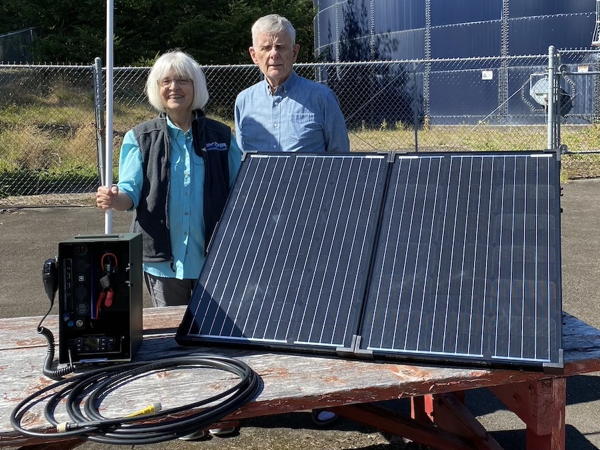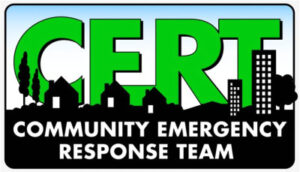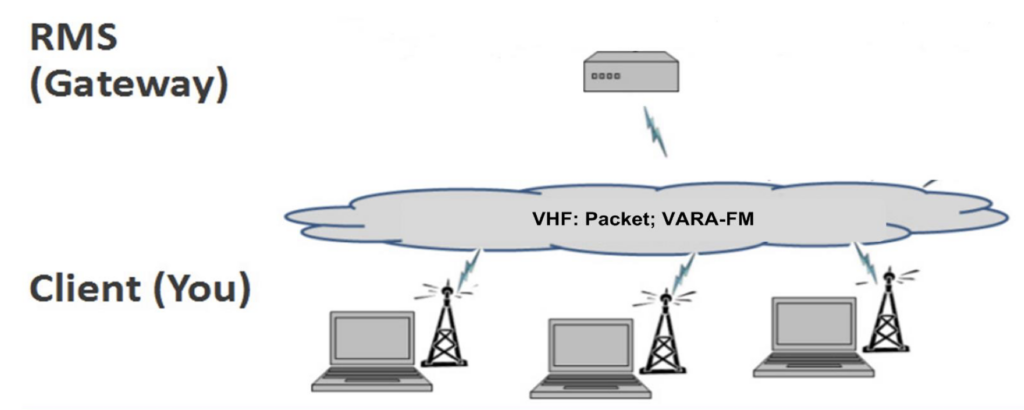ARDC helps ham radio prepare for “the big one”
Emergency and public service communications is one of the reasons that amateur radio exists. While recent advances–such as satellite communications and trunked communications systems–have perhaps diminished the importance of amateur radio in emergency communications, amateur radio still has a critical role to play.
Below are two examples of how ARDC grantees are meeting the challenge of emergency communications today. By working with existing community groups and adopting new digital technology, they are helping their communities prepare for future disasters.
Preparing for “the big one” in Tillamook County, Oregon
 In December 2007, a series of three powerful storms, dubbed the Great Coastal Gale of 2007, hit the Pacific Northwest, prompting residents of Tillamook County, Oregon, to form the Emergency Volunteer Corps of Nehalem Bay (EVCNB). EVCNB is a nonprofit organization dedicated to building personal, community and regional resilience. Since their founding, the group has been promoting what they call a “culture of preparedness.”
In December 2007, a series of three powerful storms, dubbed the Great Coastal Gale of 2007, hit the Pacific Northwest, prompting residents of Tillamook County, Oregon, to form the Emergency Volunteer Corps of Nehalem Bay (EVCNB). EVCNB is a nonprofit organization dedicated to building personal, community and regional resilience. Since their founding, the group has been promoting what they call a “culture of preparedness.”
According to Margarte Steele, president of EVCNB, one of the events they are preparing for is an earthquake along the Cascadia Subduction Zone. The Cascadia Subduction Zone is a 600-mile fault that runs from northern California up to British Columbia and is anywhere from 70 to 100 miles offshore. The last earthquake that occurred along this fault was on January 26, 1700, and scientists estimate that this earthquake would have measured 9.0 on the Richter Scale. “An earthquake of this size, and the tsunami that it would create, would be devastating now,” said Steele, “If we can be ready for a Cascadia earthquake, we can be ready for anything.”
A big part of EVCNB’s culture of preparedness is amateur radio. According to Steele, the ability to communicate is critical. This includes communication with neighbors, between neighborhoods, and between the neighborhoods and the local Emergency Operations
Center (EOC). Accordingly, EVCNB has an extensive emergency communication plan that includes both GMRS and amateur radio systems.
In August 2021, EVCNB submitted a proposal for a project that would improve the amateur radio emergency communications infrastructure in Tillamook County. The proposal included funds for a new UHF repeater on Neahkahnie Mountain and solar-powered, digital go-boxes to be distributed within Tillamook County.
Neahkahnie Mountain is the highest peak along the North Oregon Coast. Locating the UHF repeater there allows ECVNB to communicate more reliably throughout Tillamook County, as well as link to a VHF repeater in Clatsop County to the north. Fortunately, the site had space available for the ECVNB repeater in one of two existing buildings that were already housing public service repeaters, television and radio translators, and microwave links.
The site does not support solar or wind power, so ECVNB installed a battery system to provide power during an emergency. The batteries are kept charged from the commercial power lines and have sufficient capacity to keep the repeater running until backup generators begin supplying power.
In addition to installing the repeater, ECVNB used the grant to build additional solar-powered portable stations, sometimes known as go-boxes. They already had five go-boxes, but they needed more to support all of the neighborhoods that might be cut off in the case of a tsunami.

 Margaret Steele, KG7RQZ, and Bruce Maxwell, N5GB, demonstrate one of ECVNB’s solar-powered go-boxes.
The go-boxes include a 25W VHF/UHF transceiver, an antenna, two 20-Ahr LiFePO4 batteries, a terminal node controller (TNC), and a 100 W solar panel capable of charging the batteries. With the addition of a Windows laptop, these portable stations are capable of sending and receiving messages via WinLink, in addition to providing voice communications.
They had originally planned to build ten more VHF/UHF go-boxes, but they soon realized that they also needed HF capabilities for longer-range communications. So, instead of building ten additional VHF/UHF go boxes, they plan to build several HF go-boxes.
“We are beyond grateful for ARDC’s support,” Steele said. According to Steele, the new repeater and the go boxes have really enhanced their communications capabilities and their emergency preparedness, and they are continuing to work on improving both. For example, they recently held a Technician class, which resulted in a dozen people getting their licenses.
Walnut Creek hams upgrade to digital
 In northern California, they are also preparing for the big one. There, the Walnut Creek, California Community Emergency Response Team (CERT), in partnership with the Walnut Creek SHAMS Amateur Radio Club (SHAMS ARC), already had an extensive, amateur radio-based, analog (voice) emergency communication system in place. According to Don Prosnitz, N6PRZ, SHAMS ARC president, however, they saw the need to upgrade to digital communications. A digital system, he noted, would allow them to transmit digital information in a variety of formats and would provide more immediate and complete information to the city’s emergency responders.
In northern California, they are also preparing for the big one. There, the Walnut Creek, California Community Emergency Response Team (CERT), in partnership with the Walnut Creek SHAMS Amateur Radio Club (SHAMS ARC), already had an extensive, amateur radio-based, analog (voice) emergency communication system in place. According to Don Prosnitz, N6PRZ, SHAMS ARC president, however, they saw the need to upgrade to digital communications. A digital system, he noted, would allow them to transmit digital information in a variety of formats and would provide more immediate and complete information to the city’s emergency responders.
An ARDC grant of $23,220 to Walnut Creek CERT allowed the club to develop and deploy the system, which includes eight VHF digital amateur radio stations all with back-up emergency power. These stations allow CERT members in the community to stay in touch with city officials by sending and receiving messages using WinLink.
It’s WinLink with a twist, though. Most WinLink systems connect to a remote message server (RMS), which then routes email and other messages to the internet. As shown below, the Walnut Creek system uses an RMS that connects only to other systems in the Walnut Creek network. This configuration eliminates the need for an internet connection, which may not be available during some emergency situations. It also improves the privacy of the traffic, reduces noise in the network, and reduces the traffic load on the public Winlink network.

Unlike most WinLink systems that connect to a remote message server (RMS), the Walnut Creek system uses an RMS that connects only to other systems in the Walnut Creek network.
The equipment itself is relatively simple. The RMS and each client system consist of a small Windows computer, VHF radio, external sound card, antenna and power source. Client systems are equipped with laptops, while the RMS system is normally run without a keyboard and monitor. The systems have been designed to run on 12V DC power, so that they can run on battery power, solar power, or mains power.
Of course, none of this works without trained operators. To ensure that enough CERT members are properly trained, the SHAMS ARC teaches several Technician Class courses every year, as well as classes that give these new Techs some real on-air experience. As a result of this training, according to Margaret Campos, AJ6LP, Walnut Creek CERT Program manager, nearly half of the CERT’s 280 volunteers have amateur radio licenses.
Training on the new digital radio equipment and using WinLink is an important part of this project, too. They initially underestimated the amount of training that would be necessary. To address this issue, they plan to purchase a loaner system for volunteers who wish to improve their Winlink skills.
To prove out the system, the Walnut Creek CERT participated in the Great ShakeOut on October 20, 2022, an annual earthquake preparedness drill held annually on the third Thursday of October. In Walnut Creek, 45 licensed amateurs participated, using the new digital emergency communication system.
The 2022 ShakeOut was a great success. Hams at the Walnut Creek City Hall and seven of eight remote stations were successful in exchanging Winlink messages during the exercise. After the exercise, they discovered that the eighth had a defective antenna system. As a result, the CERT created a maintenance team and set up a maintenance schedule to ensure the operability of all the stations.
The group’s success has not gone unnoticed. Following the ShakeOut and a Winlink demonstration for Walnut Creek City departments, the group was asked to provide amateur radio license training for city employees. The police department, the fire department, and the public works department are all interested in the training.
In addition, the group’s technical team, headed by John Trinterud, K9ONR, has given multiple briefings on their implementation of Winlink to amateur radio clubs both inside and outside of California. They have also given Winlink briefings to officials from Alameda County and the state of California and assisted in setting up four new VHF Winlink gateways in and around Walnut Creek.
This project, which started out as a way to keep club members engaged during the pandemic, has really blossomed into something special. The hams involved have developed a unique WinLink application that has not only improved emergency communications in Walnut Creek, but has the potential to do so elsewhere as well. In addition, the project has attracted the attention of served agencies (such as the public works department) in Walnut Creek, Alameda County, and the state of California.
Do you have an idea for a project that uses new technology to improve emergency communications? If so, get in touch with us to see how you can qualify for an ARDC grant..